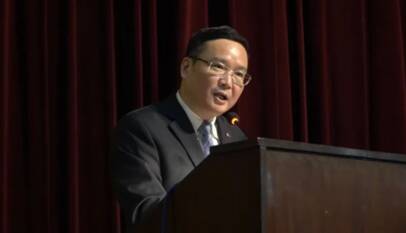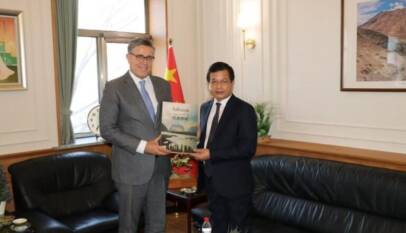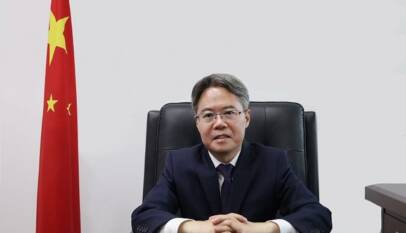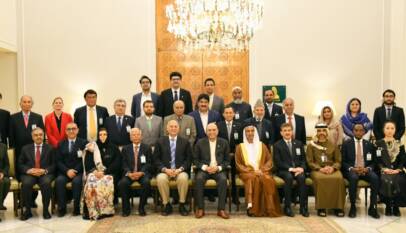Expert suggests boosting people-to-people exchanges under CPEC
Dr Liaqat Ali Shah, a columnist, writes that one of China’s three foreign policy pillars is people-to-people connectivity. He adds that the component of the China-Pakistan Economic Corridor involves cultural exchanges (CPEC). He writes that the second phase of the CPEC development plan focuses on industries including science and technology, information technology, agriculture, and socioeconomic development where inter-human connection is essential. In his article, Mr. Shah suggests that to address the urgent concerns about poverty alleviation, healthcare improvement, enhancing employability skills, and other issues, forums like China’s NGO network of International Exchanges (CNIE), Silk Road Community Building Initiative, China Foundation for Poverty Alleviation (CFPA), and China Medical Association, among others, must be connected with their counterparts in Pakistan.
People-to-people exchanges are one of China’s three main pillars of foreign policy. Trade and economic cooperation and political trust are the other two. The exchanges foster understanding among people and strengthen the social foundation for healthy international relations. And for that very reason, it is the sine qua non of the Chinese foreign policy framework and has thus been made part of the China-Pakistan Economic Corridor to achieve the intended objectives; however, its full implementation under CPEC has yet to be realized.
The people-to-people exchanges program in China is often equated with cultural exchanges and is spearheaded by the Chinese Ministry of Culture as per the Belt & Road Initiative Cultural Development Action Plan which has been formulated in line with the 13th Five-year plan. However, other ministries and departments are part and parcel of the program depending on the area of interest. The program often emphasizes health, education, science & technology, sports, tourism, and environmental protection, and is promoted through state-led interventions across countries.
The exchange program is not limited to BRI participants. The U.S.-Chinapeople-to-people exchange program (referred to as CPE) is the most extensive of all with over 150 projects across the Action Plan’s specified areas. With China’s increased emphasis on people-to-people connectivity as evidenced bya number of policy documents as well as the scope and substance of the program, it is opportune to formulate a“structured” exchange program under CPEC to achieve broader policy objectives in the areas of interest. The exchanges in CPEC have been scattered and spontaneous, thus far. For example, scholarships to Pakistani students are offered in Chinese universities but the Higher Education Commission of Pakistan is not in the picture. A few interventions in vocational education and training, health, water supply, and media in addition to livelihood and poverty alleviation projects are either done or underway. The visit of young workers to China under an MoU signed between M/o Planning Development & Special Initiative and the All-China Federation of Trade Unions (ACFTU) is another intervention to bring the people of the two countries together. However, the social space for “working together” to achieve the broader objective of a “shared future” is large and expansive, and more so in the second phase of CPEC and beyond.
The second phase of the CPEC development plan focuses on areas where people-to-people interaction is critical, such as science and technology, information technology, agriculture, and socioeconomic development. Even more so for industrialization drive as future business models will be more people-centric. In short, a broader framework to enable the exchanges is highly desirable at this stagebecause it will help make the CPEC development plan more sustainable and inclusive. The framework cannot be limited to the aforementioned areas, which are desirable but limited in scope as the Chinese ongoing people-to-people exchange program focuses beyond technical fields. Concerted efforts are required to develop tourism, and promote exchanges in cultural areas such as fine arts, heritage, and sports. Language barriers are to be overcome if the exchanges are to be productive. In hierarchical, government-to-government (G2G) relationships, one can circumvent the issue, but in the people-to-people contexts, for deeper cultural understanding, each other’s language must be promoted and properly understood. Media & journalism can be promoted to inform people of both sides of each other’s respective strengths and to become painters of each other’s image in their respective countries. Many joint cultural projects on the shared history of the Himalayas can be undertaken to bring the two nations closer together. The entertainment industry must be used to effectively channel cultural exchanges. City affiliation or sister city concept is widely used as an effective means of fostering amity among people tied in such relationship, which then translates into economic benefits, and ultimately into citizens’ prosperity.
International volunteer activities are another key area where the people to people connectivity could be materialized. More Chinese NGOs if encouraged to work could greatly promote the goodwill of the people of China in Pakistan and vice versa. For this to happen, non-governmental interactions must be encouraged and promoted. Forums such as China’s NGO network of International Exchanges (CNIE), Silk Road Community Building Initiative, China Foundation for Poverty Alleviation (CFPA), and China Medical Association among others must be connected with their counterparts in Pakistan to resolve our pressing concerns in poverty alleviation, improvement in healthcare, enhancing employability skills, etc.
In short, the exchange options are limitless, and the variety of exchanges is only limited by the imagination and available resources of the two countries. To better implement the exchange program, governments must limit their roles to the formulation, initiation, and facilitation of these exchanges. Once on track, it should hand it over, if not entirely, then at least partially, to non-governmental stakeholders. Nonetheless, for broader coordination, a joint working group under the CPEC Institutional framework may be established with private sector participation to further forge people-to-people connectivity through the CPEC platform. It is time to usepeople-to-people connectivity to facilitate the flow of people, ideas, and know-how across the Pak-China borders. It will not only serve as a channel to promote amity, tolerance, and goodwill among people outside of professional networks but will also make us active citizens of the BRI community with a shared future. It is hoped that the upcoming Prime Minister’s visit to China and the forthcoming 11th JCC meeting will give broader meaning to the people-to-people connectivity for inclusive and thus sustainable CPEC development.
Chinese Ambassador highlights significance of Third Plenary Session for China-Pakistan cooperation
The Third Plenary Session of the 20th Central Committee of the Communist Party of China ha…











